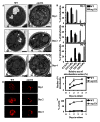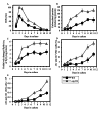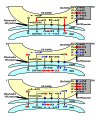Macromitophagy is a longevity assurance process that in chronologically aging yeast limited in calorie supply sustains functional mitochondria and maintains cellular lipid homeostasis
- PMID: 23553280
- PMCID: PMC3651518
- DOI: 10.18632/aging.100547
Macromitophagy is a longevity assurance process that in chronologically aging yeast limited in calorie supply sustains functional mitochondria and maintains cellular lipid homeostasis
Abstract
Macromitophagy controls mitochondrial quality and quantity. It involves the sequestration of dysfunctional or excessive mitochondria within double-membrane autophagosomes, which then fuse with the vacuole/lysosome to deliver these mitochondria for degradation. To investigate a physiological role of macromitophagy in yeast, we examined how theatg32Δ-dependent mutational block of this process influences the chronological lifespan of cells grown in a nutrient-rich medium containing low (0.2%) concentration of glucose. Under these longevity-extending conditions of caloric restriction (CR) yeast cells are not starving. We also assessed a role of macromitophagy in lifespan extension by lithocholic acid (LCA), a bile acid that prolongs yeast longevity under CR conditions. Our findings imply that macromitophagy is a longevity assurance process underlying the synergistic beneficial effects of CR and LCA on yeast lifespan. Our analysis of how the atg32Δ mutation influences mitochondrial morphology, composition and function revealed that macromitophagy is required to maintain a network of healthy mitochondria. Our comparative analysis of the membrane lipidomes of organelles purified from wild-type and atg32Δ cells revealed that macromitophagy is required for maintaining cellular lipid homeostasis. We concluded that macromitophagy defines yeast longevity by modulating vital cellular processes inside and outside of mitochondria.
Conflict of interest statement
The authors of this manuscript have no conflicts of interest to declare.
Figures










Similar articles
-
Mitochondrial membrane lipidome defines yeast longevity.Aging (Albany NY). 2013 Jul;5(7):551-74. doi: 10.18632/aging.100578. Aging (Albany NY). 2013. PMID: 23924582 Free PMC article.
-
Lithocholic acid extends longevity of chronologically aging yeast only if added at certain critical periods of their lifespan.Cell Cycle. 2012 Sep 15;11(18):3443-62. doi: 10.4161/cc.21754. Epub 2012 Aug 16. Cell Cycle. 2012. PMID: 22894934 Free PMC article.
-
Lithocholic bile acid accumulated in yeast mitochondria orchestrates a development of an anti-aging cellular pattern by causing age-related changes in cellular proteome.Cell Cycle. 2015;14(11):1643-56. doi: 10.1080/15384101.2015.1026493. Cell Cycle. 2015. PMID: 25839782 Free PMC article.
-
Amino acid homeostasis and chronological longevity in Saccharomyces cerevisiae.Subcell Biochem. 2012;57:161-86. doi: 10.1007/978-94-007-2561-4_8. Subcell Biochem. 2012. PMID: 22094422 Free PMC article. Review.
-
Mechanisms underlying the anti-aging and anti-tumor effects of lithocholic bile acid.Int J Mol Sci. 2014 Sep 18;15(9):16522-43. doi: 10.3390/ijms150916522. Int J Mol Sci. 2014. PMID: 25238416 Free PMC article. Review.
Cited by
-
Programmed cell death in aging.Ageing Res Rev. 2015 Sep;23(Pt A):90-100. doi: 10.1016/j.arr.2015.04.002. Epub 2015 Apr 8. Ageing Res Rev. 2015. PMID: 25862945 Free PMC article. Review.
-
Mechanisms by which different functional states of mitochondria define yeast longevity.Int J Mol Sci. 2015 Mar 11;16(3):5528-54. doi: 10.3390/ijms16035528. Int J Mol Sci. 2015. PMID: 25768339 Free PMC article. Review.
-
Evolutionary conservation and metabolic significance of autophagy in algae.Philos Trans R Soc Lond B Biol Sci. 2024 Nov 18;379(1914):20230368. doi: 10.1098/rstb.2023.0368. Epub 2024 Sep 30. Philos Trans R Soc Lond B Biol Sci. 2024. PMID: 39343016 Free PMC article. Review.
-
Macromitophagy, neutral lipids synthesis, and peroxisomal fatty acid oxidation protect yeast from "liponecrosis", a previously unknown form of programmed cell death.Cell Cycle. 2014;13(1):138-47. doi: 10.4161/cc.26885. Epub 2013 Oct 28. Cell Cycle. 2014. PMID: 24196447 Free PMC article.
-
Discovery of fifteen new geroprotective plant extracts and identification of cellular processes they affect to prolong the chronological lifespan of budding yeast.Oncotarget. 2020 Jun 9;11(23):2182-2203. doi: 10.18632/oncotarget.27615. eCollection 2020 Jun 9. Oncotarget. 2020. PMID: 32577164 Free PMC article.
References
Publication types
MeSH terms
Substances
Grants and funding
LinkOut - more resources
Full Text Sources
Other Literature Sources
Molecular Biology Databases
Research Materials

